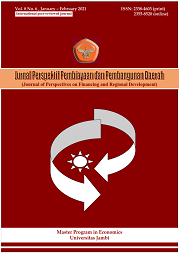Productivity of Islamic Banking in Indonesia
DOI:
https://doi.org/10.22437/ppd.v9i1.11041Keywords:
Islamic Banking, Malmquist Index Productivity, ProductivityAbstract
One measurement tool to increase banking performance, especially Islamic banking, is from the productivity side. Productivity measurement is done to determine how far a bank can run its operational activities by minimalizing input and maximalizing output results. This study aims to analyze the productivity level of Islamic Banking in Indonesia. The research sample was 11 Islamic banks from 2010 to 2019. Data obtained through financial statements and then divided into input and output variables. The productivity measurement technique by using Malmquist Index. The research shows that Islamic banking productivity with a cost approach indicates that Islamic banking has achieved a productive stage. It is seen from the average TFPCH (Total Factor Productivity Change) score that is quite high. It indicates that the decrease in Indonesia's Islamic banking growth generally occurs due to technology change
Downloads
References
Abbas, M., Hammad, R. S., Elshahat, M. F., & Azid, T. (2015). Efficiency, productivity and Islamic banks: An application of DEA and Malmquist index. Humanomics, 31(1), 118–131. https://doi.org/10.1108/H-03-2013-0022
Avenzora, A., & Jossy P., M. (2008). Analisis Produktivitas dan Efisiensi Industri Tekstil dan Produk Tekstil di Indonesia Tahun 2002-2004. [Master's Thesis] Universitas Indonesia.
Bahrini, R. (2015). Productivity of MENA Islamic banks: a bootstrapped Malmquist index approach. International Journal of Islamic and Middle Eastern Finance and Management, 8(4), 508–528. https://doi.org/10.1108/IMEFM-11-2014-0114
Basri, M. F., Muhamat, A. A., & Jaafar, M. N. (2018). The efficiency of Islamic banks in Malaysia: Based on DEA and Malmquist productivity index. Journal of Emerging Economies and Islamic Research, 6(3), 15. https://doi.org/10.24191/jeeir.v6i3.8784
Coelli, T. J., Rao, D. P., O’Donnell, C. J., & Battese, G. E. (2005). an Introduction to Efficiency and Productivity Analysis (2nd ed.). New York: Springer Science + Business Media Inc.
Griffel-Tatje, E. and Lovell, C. A. K. (1996). Deregulation and productivity decline: the case ofSpanish saving banks. European Economic Review, 40(No. 6), 1281-1303.
Hadad, M. D., Hall, M. J. B., Kenjegaliev, K. A., Santoso, W., & Simper, R. (2011). Productivity changes and risk management in Indonesian banking: A Malmquist analysis. Applied Financial Economics, 21(12), 847–861. https://doi.org/10.1080/09603107.2010.537636
Kalluci, Irini. 2018. Albanian Banking Sector Productivity Using Malmquist Index. Research Journal of Finance and Accounting. Vol 9, No. 12.
Kamarudin, F., Hue, C. Z., Sufian, F., & Anwar, N. A. M. (2017). Does Productivity of Islamic Banks Endure Progress or Regress? Empirical Evidence using Data Envelopment Analysis Based Malmquist Productivity Index. Humanomics (Vol. 33). https://doi.org/10.1108/H-08-2016-0059
Kumbhakar, S.C. & Lovell, C. a. K., 2000. Stochastic frontier analysis. Stochastic frontier analysis, 69, p.680.
Neupane, B. (2013). Efficiency and Productivity of Commercial Banks in Nepal: A Malmquist Index Approach. Asian Journal of Finance & Accounting, 5(2), 220. https://doi.org/10.5296/ajfa.v5i2.4326
Octrina, F., Primiana, I., Anwar, M., Herwany, A., & Rusnoto Susanto, M. (2019). Malmquist Index Productivity of Indonesian Bank: Based on Commercial Bank Business Group. International Journal of Recent Technology and Engineering, 8(1C2).
Octrina, F., Setiawati, R., Asnawi, A., & Putri, R. K. (2020). Produktivitas Perbankan Indonesia dengan Pendekatan Malmquist Index Productivity. Jurnal Sain Manajemen, 2(1), 45-55.
Otaviya, S. A., & Rani, L. N. (2020). Productivity and Determinant of Islamic Banks Evidence From Indonesia. Journal of Islamic Monetary Economics and Finance, 6(1), 189–212. https://doi.org/10.21098/jimf.v6i1.1146
Rani, L. N., Widiastuti, T., & Rusydiana, A. S. (2018). Comparative Analysis of Islamic Bank’s Productivity and Conventional Bank’s in Indonesia Period 2008-2016. 1st International Conference on Islamic Ecnomics, Business and Philanthropy. Bandung
Raphael, G. (2013). A DEA-Based Malmquist Productivity Index approach in assessing performance of commercial banks: Evidence from Tanzania. European Journal of Business and Management, 5(6), 2222–2839.
Rodoni, A., Salim, M. A., Amalia, E., & Rakhmadi, R. S. (2017). Comparing Efficiency and Productivity in Islamic Banking : Case Study Indonesia, Malaysia and Pakistan. Al-Iqtishad: Journal of Islamic Economics, 9(2), 227–242. https://doi.org/10.15408/aiq.v9i2.5153
Rusydiana, A. S. (2018). Indeks Malmquist untuk Pengukuran Efisiensi dan Produktivitas Bank Syariah di Indonesia. Jurnal Ekonomi Pembangunan, 26(1), 47–58. https://doi.org/10.14203/jep.26.1.2018.47-58
Rusydiana, A. S., Laila, N., & Sudana, S. (2019). Efisiensi dan produktivitas industri perbankan pada sistem moneter ganda di Indonesia. Jurnal Siasat Bisnis, 23(1), 50–66. https://doi.org/10.20885/jsb.vol23.iss1.art5
Sellers-rubio, R., & Mas-ruiz, F. (2007). An empirical analysis of productivity growth in retail services : evidence from Spain. International Journal of Service Industry Management, 18(1), 52-69. https://doi.org/10.1108/09564230710732894
Sufian., F., & Habibullah., M. S. (2014). Banks’ Total Factor Productivity Growth in a Developing Economy: Does Globalisation Matter? Journal of International Development, 26, 821–852.
Sufian, F. (2009). Sources of TFP growth in the Malaysian Islamic banking sector. Service Industries Journal, 29(9), 1273–1291. https://doi.org/10.1080/02642060801911128
Suzuki, Y., & Sastrosuwito, S. (2011). Efficiency and Productivity Change of the Indonesian Commercial Banks. IACSIT Press, 7, 10–14.
Usman, N., Andriyani, L., & Pambuko, Z. B. (2019). Productivity of Islamic Banks in Indonesia: Social Funds versus Financial Funds. Journal of Asian Finance, Economics and Business, 6(3), 115–122. https://doi.org/10.13106/jafeb.2019.vol6.no3.115
Yildirim, I. (2015). Financial Efficiency Analysis in Islamic Banks: Turkey and Malaysia Models. Pressacademia, 2(3), 289–289. https://doi.org/10.17261/pressacademia.2015312956
Downloads
Published
How to Cite
Issue
Section
License
Copyright (c) 2021 Fajra Octrina, Alia Gantina Siti Mariam

This work is licensed under a Creative Commons Attribution 4.0 International License.

















